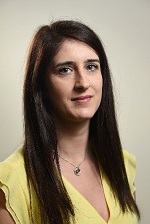Editors’ pick
Atlas construction and spatial normalisation to facilitate radiation-induced late effects research in childhood cancer - PDF Version
Catarina Veiga, Pei Lim, Virginia Marin Anaya, Edward Chandy, Reem Ahmad, Derek D’Souza, Mark Gaze, Syed Moinuddin and Jennifer Gains
Phys Med Biol (2021), 66, 105005, DOI: https://doi.org/10.1088/1361-6560/abf010
What was your motivation for initiating this study?
Survivors of childhood cancer are at risk of developing a variety of acute, long-term, and late effects of treatment, which can develop even in organs and tissues outside the target volume. For example, children treated with radiation to the brain may suffer from intellectual impairment and are at higher risk of developing new cancers elsewhere in the body later in life. The reduction of side-effects of treatment are considered to be one of the most important challenges of childhood cancer treatment, yet the current understanding of dose-response relationships is still limited in paediatric populations. Advanced methods of analysis of radiation-response relationships that consider the three-dimensional (3D) distribution of doses (rather than dose-volume histograms) are becoming increasingly popular in adult cohorts, but although they are of great interest in younger populations, they remain unexplored. The main advantage of such approaches is the potential to identify anatomical and/or functional sub-regions of organs that are linked to poor outcomes. In this study, we investigated ways in which we could apply these latest techniques to the paediatric population, and we aimed to facilitate voxel-based analysis of radiation-induced toxicities in future studies.
What were the main challenges during the work?
Voxel-based analysis requires the spatial normalisation into a common reference space of the 3D anatomical, functional and/or treatment (dose) information from a set of individuals through use of deformable image registration (DIR). The main challenge we faced was how to achieve acceptable accuracy when computed tomography (CT) scans from childhood cancer populations were co-registered. This application of DIR is very challenging due to the large variability in shapes and sizes of treated organs across genders and developmental stages, as well as atypical radiological features that can be caused by the disease or its treatment (e.g., with the use of shunts). To reduce bias in the choice of a reference space in such a diverse population, we opted to construct a population-representative atlas for spatial normalisation, which we built using CT scans of a group of 20 cranio-spinal irradiation (CSI) patients and a groupwise image-registration approach that was tailored to this application.
What is the most important finding of your study?
We developed and evaluated an atlas-based reference CT. This achievement showed that this reference space was adequate to standardise satisfactorily a very heterogeneous population at a whole-body level, which in our study included subjects aged one to 16 years, of both sexes, from different disease groups. We obtained average dice-similarity scores that ranged from 0.65±0.16 (bladder) to 0.96±0.01 (lungs) after co-registration to the reference CTs of six organs across the body.
What are the implications of this research?
This research has shown that it is possible to standardise the complex paediatric population spatially. The use of a CSI-based template enables the combination of data from different patient groups for subsequent analysis of varied clinical endpoints in large outcome studies. The proposed use of average atlases instead of individual subjects for spatial normalisation reduces bias in subsequent analysis and may facilitate the standardisation of voxel-based analysis studies, as well as collaboration across institutions. Furthermore, we demonstrate the application of the methodology to facilitate risk assessment and modelling of radiation-induced second cancers – the leading cause of mortality in long-term survivors of childhood cancer. The reference CT has the potential to serve as a computational phantom for dose reconstruction in anatomical regions that have not been imaged at the planning stage.

Catarina Veiga
Centre for Medical Image Computing
University College London
London, United Kingdom
c.veiga@ucl.ac.uk